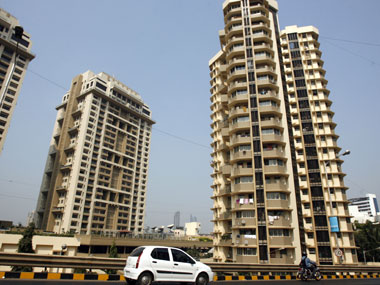Mumbai real estate is among the most expensive in the world - more than that of Tokyo or New York - and there is no shortage of those who can afford to pay. But in a space-crunched city, affordable over luxury is the preferred investment option, and even Mumbai’s wealthy seem to agree.
Anil Prasanda, an investment banker with a foreign bank, just moved out of his plush 2BHK apartment in Lower Parel for a massive 3BHK in Thane, not just for better returns but also because it offered a better quality of life. Prasanda bought the flat in 2008 and is now ready to move back to the suburbs. “Thane has really come up in the last five years.. railway, infrastructure, education, retail and commercial activity is on an uptick,” he said, adding that Ghodbunder Road is definitely a wise investment as prices have doubled in the last one year alone.
[caption id=“attachment_379743” align=“alignleft” width=“380”]  Reuters[/caption]
But why would anyone prefer Thane over Lower Parel from an investment point of view?
Industry experts claim prices in the Mumbai Metropolitian Region (MMR) region have almost topped out. This means that any more appreciation from the current levels is tough.
City properties have become frightfully expensive and are now virtually out of bounds for even the upper middle class, while suburban residential complexes continue to be available at comparatively reasonable rates.
A building boom, which stretched from the early 1990s to the global recession in 2009, turned some Navi Mumbai neighbourhoods into upper-middle-class citadels - especially those with easy public transport into the upwardly mobile parts of Mumbai. As a _Firstpost a_rticle noted earlier, “the twin attractions of comfortable living and affordable rates are hard to ignore.”
Inside Mumbai, investing in a premium flat in posh areas like Bandra, Worli, Andheri, etc, will cost a bomb and even the return on investment might not be as great as an investment in a premium flat in the suburbs of Navi Mumbai, Thane, etc. The main reasons backing the growth that Navi Mumbai has witnessed include infrastructural developments like the proposed international airport, and road widening projects, among others.
But will speculators allow the suburbs to remain affordable or will they artificially jack up prices here too so that the aam aadmi is forced to relocate to the outskirts of Pune or Karjat?
Going by the historical trends in Mumbai realty, the likelihood of an affordable suburb is next to impossible.
“Vertically huge towers are being created but there are no new buyers even in posh Navi Mumbai areas of Palm Beach! It is the rich who are getting richer day by day by booking these flats and that too for an investment purpose,” Vicky Pinto, a Navi Mumbai broker told Firstpost. End-users end up paying a higher price because these flats are being used as tradable instruments by the same buyers who once speculated in Greater Mumbai and have now turned their attention to the suburbs for higher returns.
Mumbai’s property market has become more speculation-based and less about homes. Flats are being traded as investments, driving up prices inordinately.
“Buyers will purchase houses at an unjustified price today for the reason that it will become even more unjustifiable going forward,” explained Pankaj Kapoor**,** MD at property research firm Liasas Foras, but he warned that entering the market now is a bad idea as realty prices are at their peaks. Even those investors that bought flats four years back in far-flung areas are unable to find buyers at these levels, he said.
The problem with such play is that you can never be sure if there will be a bigger fool waiting to buy from you, or if you are the biggest fool.
Mumbai’s market for high-end homes has already stagnated during FY2012 and dropped by more than 60 percent from 2007 and 35 percent from 2010-11, with South and Central Mumbai, which only offer products at the premium end, experiencing the highest vacancy levels. According to a Knight Frank report, approximately 45 percent of the planned launches in financial year 2013 will be in these micro-markets. This is likely to put further pressure on vacancy levels and prices prevailing there.
“When housing is an object of trade, it goes out of the reach of a majority of people,” lamented PK Ghosh, who has been wanting to buy a 2BHK in Vashi for the last two years by selling his 1BHK but is unable to do so because the price of the former shot up to around Rs 1 crore in less than two years.
“The announcement of the planned airport in 2007-08 created a lot of hype resulting in increased land acquisition. A number of projects were announced, and speculation became an element, said Subhankar Mitra, associate director-strategic consulting, Jones Lang LaSalle India.
For less than Rs 1 crore the best one can hope for is an 800-sq ft house in a far suburb of Mumbai like Kalyan, Badlapur, or Panvel as the average Mumbai flat costs nothing less than Rs 2.38 crore. “For someone drawing Rs 20 lakh a year, a flat costing Rs 75 lakh will only be available in Mira Road in the western suburbs. He is better off taking a house on rent in Kandivli as the gap between owning a house and renting is still 10 times more,” said Kapoor.


)
)
)
)
)
)
)
)
)



